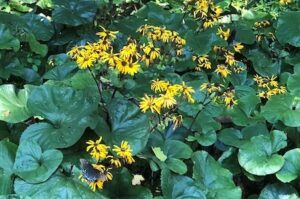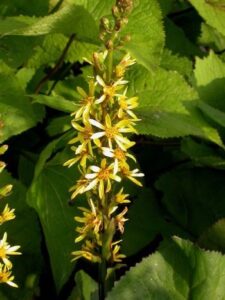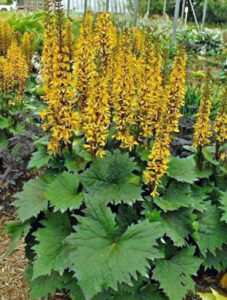Ligularia: Yes to Shade, No to Deer
by Mary Francis, Fairfax County Master Gardener

Ligularia dentata ‘Desdomona’
Are you looking for a new plant for your shade garden or your rain garden? Ligularias may fill your needs. These herbaceous perennials are often chosen for their handsome foliage alone. They also have attractive flowers that attract butterflies and bees. They are hardy in zones 4 through 8 and are highly deer resistant, in Fairfax from my personal experience. Most of the approximately 150 species of the genus Ligularia are native to China, Japan and Siberia. Common names for Ligularias include leopard plant, ragwort, golden groundsel and bigleaf goldenray.
Ligularias grow well in dappled shade, part shade or full shade. Too much sun causes the leaves to wilt. A primary requirement to success with Ligularias is moist soil, preferably one rich and high in humus. Protection from wind is highly desirable. Siting them near a pond or stream is ideal. They are suitable for a woodland garden, a boggy area or for planting in containers.

Ligularia siberica flowers
Ligularias look well as specimen plants, or they can be grouped in large masses. They are somewhat fast growing with a rounded form. Depending on the species, they reach a height of 3 to 5 feet and a spread of 2 to 4 feet. They tend to form impressive clumps via seedlings, which can easily be relocated if desired, or they can be propagated by division in early spring or fall. They do not spread via underground structures such as rhizomes.
The foliage is quite striking. The leaves can be more than 12 inches wide. Foliage forms a circle at the base of the stem (a basal rosette). The leaves can be heart shaped (cordate), triangular, or flat and circular (orbicular). Leaf arrangement is opposite. The leaves are dentate (toothed) and perch on petioles two to three feet long. Some species such as Ligularia stenocephala ‘The Rocket,’ have gigantic green cordate leaves with deep, coarsely dentated edges. Others such as Ligularia dentata ‘Desdomona’ have smaller cordate leaves with shallow dentation and distinct burgundy undertones. Some species have purple stems.
Showy blooms appear on tall stalks above the foliage beginning in June and persisting into September. The flowers may rise as much as 5 feet above the leaves. These groups of small flowers are arranged on a stem forming an inflorescence. The flowers resemble small daisies that range in color from lemon yellow to golden yellow to yellowish orange. Some species have corymbose heads, which are flat-topped flower clusters with the individual flower stalks growing upward from various points of the main stem. Other species have unbranched flower spikes with flowers along the axis (racemes). These flower spikes can reach as much as 5 feet high with large numbers of flowers along the spike.

Ligularia stenocephala ‘The Rocket’
Ligularias have almost no pest or disease problems. Snails or slugs may be attracted to the foliage. The plants may wilt in too much sun. Particularly good companion plants are interrupted fern (Osmunda claytonia) or Japanese sedge (Carex morrowii).
Two of the numerous species in the genus Ligularia are of particular landscape interest. L. dentata (bigleaf ligularia), grows 3 to 4 feet high with bright orange flowers and heart shaped leaves. Cultivars include ‘Dark Beauty’ with bright orange flowers and dark leaves, ‘Othello’ with smaller bright orange flowers and ‘Desdomona.’
L. stenocephala (narrow spiked Ligularia) has heart shaped leaves up to 12 inches wide. The imposing cultivar ‘The Rocket’ can reach a height of 5 feet with flower spikes of 4 to 5 feet above the foliage. It mixes well with or behind other perennials. ‘Little Rocket’ is similar to ‘The Rocket’ but grows 3 to 4 feet tall.
Resources
Landscape Plants by Deer Resistance, Rutgers University
Ligularia, University of Vermont
Ligularia ‘The Rocket,’ Missouri Botanical Garden
Ligularia dentata, Missouri Botanical Garden